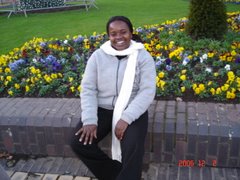I read the article and think of colour polmorphism evolution rather than speciation. But as everyboyd has said the results are interesting and the study was well set.
Hastings
VIEWS FROM THE SCIENTIST
Capturing the eye of a potential mate is the first step in propagating a species. But can the way a female sees males of a certain color lead a single species of fish to split into two? A study published this week in Nature suggests two species of cichlid fish -- one red and one blue -- may have arisen from the female mating preference for males she is best able to see. "We've wanted since Darwin to understand how species originate," said Karen Carleton, a biologist at the University of Maryland and co-author of the study. "This is one of first times we've been able to understand from the molecular level to the fish to the environment to get the whole picture." Researchers have long believed that geographic isolation was the primary force behind the evolution of a single species into two reproductively incompatible groups, yet, as lead author and evolutionary biologist Ole Seehausen, found in Lake Victoria in eastern Africa, the red and blue cichlids were separated by as little as 15 meters of water. Earlier studies showed that red cichlids live closer to the lake bottom, while the blue cichlids frequent more shallow waters, and the females (dressed in muted yellow fins) chose the most vibrantly colored of the males at their water depth. To understand factors driving female mating preference, Seehausen's team examined light gradients in different depths of water and the opsin gene, which produces a protein that detects color. "We knew about the mating preferences [in cichlids] but we did not know where in the process the divergent evolution at the opsin gene locus occurred," Seehausen said. The researchers genotyped the opsin gene of cichlids from five islands in Lake Victoria and identified the gene's variants in the red and blue cichlids. They then expressed the genes in vitro, showing that the protein product of each variant absorbed light at a different wavelength: in red cichlids, the protein was more sensitive to red light, while in blue cichlids it was more sensitive to blue light. Meanwhile, light gradient data showed blue light was more easily visible in shallow water and red light in deep water. The findings suggest that natural selection in each species' visual system toward red- or blue- sensitivity, which allows cichlids to best navigate their environment, may also drive females to the males they are best able to see. "The evidence shows that in a heterogeneous environment, where different conditions prevail along a gradient, selection is strong enough to create two species," said Seehausen. Trevor Price, who studies the evolution of color patterns in birds at the University of Chicago, said he's excited about Seehausen's model, but stressed that more evidence is needed to "make the connection that female color vision is driving speciation." Females with the red-biased and blue-biased opsin variants generated from controlled crosses in Seehausen's lab demonstrated no preference between red and blue males in the lab tank. "These findings suggests the opsin gene themselves are not causing mating preference," Seehausen said. "It could be the interaction of visual gene and ambient lighting." Seehausen said his group plans to look for additional genes and traits involved in mate choice in cichlids in order to understand how these interact with the adaptation of the visual system.
Thursday, October 30, 2008
Tuesday, October 7, 2008
THE HUMAN DIVERSITY MAY BE COMING TO A HALT
Hi
Here is another mind blowing article on the componets that determine the human
diversity and indeed all living creatures on our planet earth.
The people on the driving seat are warning that,while these processes may be still at
work in other organism just like our super radiation of Lake Malawi cichlid fish, the story
is different in human populations.
However, as we live in an ever changing universe the story may not be as simple as we
may see it. In mind is the global warming issue. With most of the areas on earth
claimed to be at risk, the human population may be heading for a revolution of
their diversity in the near or distant future. The effective population size might
be at risk and random drift will play its part, thus reshuffling the diversity as
well.
All in all its intersting and informative to know how our diversity is struggling at
the moment.
Have a good time read on the article below.
Hastings
========
Press Assoc. - Tuesday, October 7 04:21 am
Human evolution is grinding to a halt, according to a leading genetics expert.
The gloomy message from Professor Steve Jones is: this is as good as it gets.
Prof Jones, from the Department of Genetics, Evolution and Environment at University College London, believes the mechanisms of evolution are winding down in the human race.
At least in the developed world, humans are now as close to utopia as they are ever likely to be, he argues. Speaking at a UCL Lunch Hour Lecture in London, Prof Jones said there were three components to evolution - natural selection, mutation and random change.
He said: "In ancient times half our children would have died by the age of twenty. Now, in the Western world, 98% of them are surviving to the age of 21. Our life expectancy is now so good that eliminating all accidents and infectious diseases would only raise it by a further two years. Natural selection no longer has death as a handy tool."
Mutation rate was also slowing down, he said. Although chemicals and radioactive pollution could cause genetic changes, one of the most important mutation triggers was advanced age in men. "Perhaps surprisingly, the age of reproduction has gone down - the mean age of male reproduction means that most conceive no children after the age of 35," said Prof Jones. "Fewer older fathers means that if anything, mutation is going down."
Random alterations to the human genetic blueprint were also less likely in a world that had become an ethnic melting pot, according to Prof Jones.
He said: "Humans are 10,000 times more common than we should be, according to the rules of the animal kingdom, and we have agriculture to thank for that. Without farming, the world population would probably have reached half a million by now - about the size of the population of Glasgow.
"Small populations which are isolated can change - evolve - at random as genes are accidentally lost. Worldwide, all populations are becoming connected and the opportunity for random change is dwindling. History is made in bed, but nowadays the beds are getting closer together. Almost everywhere, inbreeding is becoming less common. In Britain, one marriage in fifty or so is between members of a different ethnic group, and the country is one of the most sexually open in the world. We are mixing into a global mass, and the future is brown."
He added: "So, if you are worried about what utopia is going to be like, don't; at least in the developed world, and at least for the time being, you are living in it now."
Here is another mind blowing article on the componets that determine the human
diversity and indeed all living creatures on our planet earth.
The people on the driving seat are warning that,while these processes may be still at
work in other organism just like our super radiation of Lake Malawi cichlid fish, the story
is different in human populations.
However, as we live in an ever changing universe the story may not be as simple as we
may see it. In mind is the global warming issue. With most of the areas on earth
claimed to be at risk, the human population may be heading for a revolution of
their diversity in the near or distant future. The effective population size might
be at risk and random drift will play its part, thus reshuffling the diversity as
well.
All in all its intersting and informative to know how our diversity is struggling at
the moment.
Have a good time read on the article below.
Hastings
========
Press Assoc. - Tuesday, October 7 04:21 am
Human evolution is grinding to a halt, according to a leading genetics expert.
The gloomy message from Professor Steve Jones is: this is as good as it gets.
Prof Jones, from the Department of Genetics, Evolution and Environment at University College London, believes the mechanisms of evolution are winding down in the human race.
At least in the developed world, humans are now as close to utopia as they are ever likely to be, he argues. Speaking at a UCL Lunch Hour Lecture in London, Prof Jones said there were three components to evolution - natural selection, mutation and random change.
He said: "In ancient times half our children would have died by the age of twenty. Now, in the Western world, 98% of them are surviving to the age of 21. Our life expectancy is now so good that eliminating all accidents and infectious diseases would only raise it by a further two years. Natural selection no longer has death as a handy tool."
Mutation rate was also slowing down, he said. Although chemicals and radioactive pollution could cause genetic changes, one of the most important mutation triggers was advanced age in men. "Perhaps surprisingly, the age of reproduction has gone down - the mean age of male reproduction means that most conceive no children after the age of 35," said Prof Jones. "Fewer older fathers means that if anything, mutation is going down."
Random alterations to the human genetic blueprint were also less likely in a world that had become an ethnic melting pot, according to Prof Jones.
He said: "Humans are 10,000 times more common than we should be, according to the rules of the animal kingdom, and we have agriculture to thank for that. Without farming, the world population would probably have reached half a million by now - about the size of the population of Glasgow.
"Small populations which are isolated can change - evolve - at random as genes are accidentally lost. Worldwide, all populations are becoming connected and the opportunity for random change is dwindling. History is made in bed, but nowadays the beds are getting closer together. Almost everywhere, inbreeding is becoming less common. In Britain, one marriage in fifty or so is between members of a different ethnic group, and the country is one of the most sexually open in the world. We are mixing into a global mass, and the future is brown."
He added: "So, if you are worried about what utopia is going to be like, don't; at least in the developed world, and at least for the time being, you are living in it now."
Subscribe to:
Posts (Atom)





